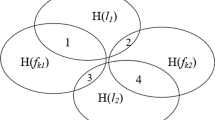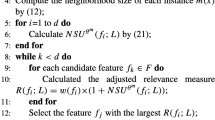Abstract
Feature selection plays an important role in high-dimensional multi-source data, which can improve classification performance of learning algorithm. Most of existing multi-source information fusion focus on the single decision system without considering multi-source and multi-label problems together. Nevertheless, data from different sources along with multiple labels simultaneously are absolutely frequent in many real-world applications. For this issue, in this paper, a multi-source multi-label decision system is proposed, which has more than one decision label. To remove some redundant or irrelevant features in multi-source multi-label decision system, a feature selection algorithm based on positive region for multi-source multi-label data is explored, which uses the feature dependency carried on the fusion decision table. Finally, examples are introduced to elaborate the detail process of the proposed algorithm, and experimental results show the effective performance of the proposed algorithm on multi-source and multi-label data.


Similar content being viewed by others
References
Wu X, Zhu X, Wu GQ et al (2014) Data mining with big data. IEEE Trans Knowl Data Eng 26(1):97–107
Wang YZ, Jin XL, Cheng XQ (2013) Networking big data:present and future. Chin J Comput 36(6):1125–1138
Zhao J, Guan X, Li X (2013) Power allocation based on genetic simulated annealing algorithm in cognitive radio networks. Chin J Electron 22(1):177–180
Zhang J, Li CD, Sun ZQ, Luo ZM, Li SZ (2019) Towards a unified multi-source-based optimization framework for multi-label learning. Appl Soft Comput 76:425–435
Zhao J, Yang T, Gong Y, Wang J, Fu L (2013) Power control algorithm of cognitive radio based on non-cooperative game theory. China Commun 10(11):143–154
Poggio T, Smale S (2005) The mathematics of learning: dealing with data. Found Adv Data Min 180:1–19
Pawlak Z, Skowron A (2007) Rudiments of rough sets. Inf Sci 177(1):3–27
Qian YH, Liang JY, Yao YY, Dang CY (2010) MGRS: a multigranulation rough set. Inf Sci 180:949–970
Feng F, Liu XY, Leoreanu-Fotea V, Jun YB (2011) Soft sets and soft rough sets. Inf Sci 181:1125–1137
Feng F, Li CX, Davvaz B, Ali MI (2010) Soft sets combined with fuzzy sets and rough sets: a tentative approach. Soft Comput 14(9):899–911
Shaheen T, Mian B, Shabir M, Feng F (2019) A novel approach to decision analysis using dominance-based soft rough sets. Int J Fuzzy Syst 21(3):954–962
Khan MA, Banerjee M (2008) Formal reasoning with rough sets in multiple-source approximation systems. Int J Approx Reason 49:466–477
Li TC, Pintado FDLP, Corchado JM, Bajo J (2017) Multi-source homogeneous data clustering for multi-target detection from cluttered background with misdetection. Appl Soft Comput 60:436–446
Hathaway RJ, Bezdek JC, Pedrycz W (1996) A parametric model for fusing heterogeneous fuzzy data. IEEE Trans Fuzzy Syst 4(3):270–281
Grzymala-Busse JW (1991) Managing uncertainty in expert systems. Kluwer Academic Publishers, Norwell
Grzymala-Busse JW (1992) LERS—a system for learning from examples based on rough sets. In: Slowinski R (ed) Intelligent decision support, theory and decision library, vol 11. Springer, Dordrecht, pp 3–18
Lee J, Kim DW (2015) Fast multi-label feature selection based on information-theoretic feature ranking. Pattern Recognit 48:2761–2771
Guo Y, Xu WH (2016) Attribute reduction in multi-source decision systems. Int Joint Conf Rough Sets 9920:558–568
Xu WH, Li MM, Wang XZ (2017) Information fusion based on information entropy in fuzzy multi-source incomplete information system. Int J Fuzzy Syst 19:1200–1216
Huang J, Li GR, Huang QM et al (2017) Joint feature selection and classification for multilabel learning. IEEE Trans Cybern 48(3):876–889
Qian YH, Liang JY, Pedrycz W et al (2010) Positive approximation: an accelerator for attribute reduction in rough set theory. Artif Intell 174(9–10):597–618
Nan GF, Li QW, Dou RL, Liu J (2018) Local positive and negative correlation-based k-labelsets for multi-label classification. Neurocomputing 318:90–101
Qian YH, Liang JY (2008) Positive approximation and rule extracting in incomplete information systems. Int J Comput Sci Knowl Eng 2(1):51–63
Hu QH, Yu D et al (2006) Fuzzy probabilistic approximation spaces and their information measures. IEEE Trans Fuzzy Syst 14(2):191–201
Li F, Miao DQ, Pedrycz W (2017) Granular multi-label feature selection based on mutual information. Pattern Recognit 67:410–423
Dasarathy BV (2004) Multi-sensor, multi-source information fusion: architecture, algorithms, and applications—a panoramic overview. In: Second IEEE international conference on computational cybernetics, Vienna
Ribeiro RA, Falcão A, Mora A, Fonseca JM (2014) FIF: a fuzzy information fusion algorithm based on multi-criteria decision making. Knowl Based Syst 58:23–32
Sang B, Guo Y, Shi D, Xu WH (2018) Decision-theoretic rough set model of multi-source decision systems. Int J Mach Learn Cybern 9:1941–1954
Zhou X, Jiang P (2017) Variation source identification for deep hole boring process of cutting-hard workpiece based on multi-source information fusion using evidence theory. J Intell Manuf 28(2):255–270
Xu WH, Yu JH (2017) A novel approach to information fusion in multi-source datasets: a granular computing viewpoint. Inf Sci 378:410–423
Rauszer C (2005) Rough logic for multi-agent systems. In: International conference on logic at work. Knowledge representation and reasoning under uncertainty, vol 808, pp 161–181
Khan MA (2016) Formal reasoning in preference-based multiple-source rough set model. Inf Sci 334:122–143
Pawlak Z (1982) Rough sets. Int J Comput Inf Sci 11(5):341–356
Mani A (2013) Towards logic’s of some rough perspectives of knowledge. Rough Sets Intell Syst Profr Zdzisław Pawlak Mem 43:419–444
Dai JH, Wang WT, Q X (2013) An uncertainty measure for incomplete decision tables and its applications. IEEE Trans Cybern 43(4):1277–1289
Zheng YF, Shi HJ (2011) Attribute reduction algorithm based on relation coefficient and conditional information entropy. Comput Eng Appl 47(16):26–28
Wu SZ, Guo PZ (2011) Attribute reduction algorithm on rough set and information entropy and its application. Comput Eng 37(7):56–58
Wei W, Liang JY (2019) Information fusion in rough set theory: an overview. Inf Fusion 48:107–118
Battiti R (1994) Using mutual information for selecting features in supervised neural net learning. IEEE Trans Neural Netw 5(4):537–550
Hu QH, Zhang L, Zhang D, Pan W, An S, Pedrycz W (2011) Measuring relevance between discrete and continuous features based on neighborhood mutual information. Exp Syst Appl 38:10737–10750
Wang X, Yang J, Teng XL, Xia WJ, Jensen R (2007) Feature selection based on rough sets and particle swarm optimization. Pattern Recognit Lett 28(4):459–471
Zhang ML, Zhou ZH (2014) A review on multi-label learning algorithms. IEEE Trans Knowl Data Eng 26:1819–1837
Wu XZ, Zhou Z (2017) A unified view of multi-label performance measures. In: Proceedings of the 34th international conference on machine learning, vol 70, pp 3780–3788
Demšr J (2006) Statistical comparisons of classifiers over multiple data sets. J Mach Learn Res 7:1–30
Acknowledgements
This work is supported by National Natural Science Foundation of China (Nos. 61966016 and 61502213), the Natural Science Foundation of Jiangxi Province (No. 20192BAB207018), the Scientific Research Project of Education department of Jiangxi Province (No. GJJ180200).
Author information
Authors and Affiliations
Corresponding author
Additional information
Publisher's Note
Springer Nature remains neutral with regard to jurisdictional claims in published maps and institutional affiliations.
Rights and permissions
About this article
Cite this article
Qian, W., Yu, S., Yang, J. et al. Multi-label feature selection based on information entropy fusion in multi-source decision system. Evol. Intel. 13, 255–268 (2020). https://doi.org/10.1007/s12065-019-00349-9
Received:
Revised:
Accepted:
Published:
Issue Date:
DOI: https://doi.org/10.1007/s12065-019-00349-9




